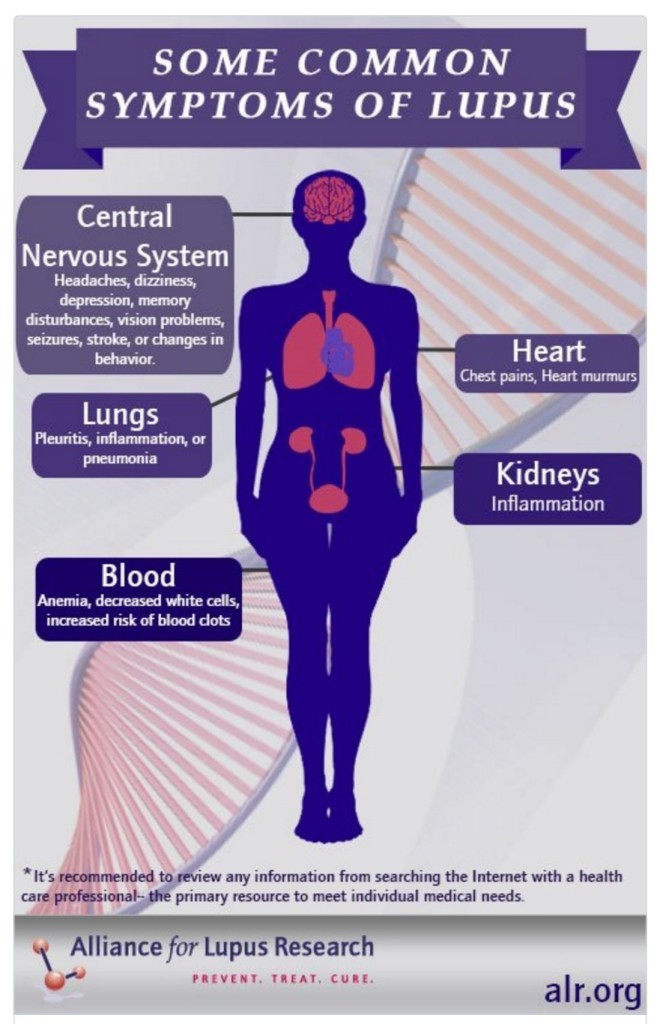Lupus is an autoimmune disease in which the tissues of the body are attacked by the overly active immune system and it is treated by suppressing the immune system.
Lupus can affect many parts of the body, including the joints, skin, kidneys, heart, lungs, blood vessels, and brain. Although people with the disease may have many different symptoms, some of the most common ones include extreme fatigue, painful or swollen joints (arthritis), unexplained fever, skin rashes, and kidney problems.
At present, there is no cure for lupus. However, lupus can be effectively treated with drugs, and most people with the disease can lead active healthy lives. Lupus is characterized by periods of illness, called flares, and periods of wellness, or remission. Understanding how to prevent flares and how to treat them when they do occur helps people with lupus maintain better health.
According to the Lupus Foundation of America, there are at least 1.5 million Americans have Lupus. The actual number may be higher; however, there have been no large-scale studies to show the actual number of people in the U.S. living with lupus.
What Causes Lupus?
The immune system is the body’s defense system. When healthy, it protects the body by making antibodies (blood proteins) that attack foreign germs and cancers. With lupus, the immune system misfires. Instead of producing protective antibodies, an autoimmune disease begins and makes “autoantibodies,” which attack your own body’s healthy tissues.

As the attack goes on, other immune cells join the fight. This leads to inflammation and abnormal blood vessels. These antibodies then end up in cells in organs, where they damage those tissues. Why this inflammatory response begins is not clear. It most likely results from a mix of inherited tendencies and things in your environment. These include viruses, sunlight and drug allergies. People with lupus may also have an impaired process for clearing old and damaged cells from the body, which causes an abnormal immune response.
Risk Factors
- Lupus strikes mostly women of childbearing age (15-44). It occurs 10 times more often in women than in men.
- However, men, children, and teenagers develop lupus, too.
- Women of color are two to three times more likely to develop lupus than Caucasians.
- People of all races and ethnic groups can develop lupus.
Common Lupus Symptoms
Lupus is sometimes called the “great imitator” because of its wide range of symptoms which often mimic those of other ailments. This is a major reason why Lupus can be difficult to diagnose. The most distinctive sign of lupus is a facial rash that resembles the wings of a butterfly unfolding across both cheeks occurs in many but not all cases of lupus.
- Extreme fatigue (tiredness)
- Headaches
- Painful or swollen joints
- Fever
- Anemia (low numbers of red blood cells or hemoglobin, or low total blood volume)
- Swelling (edema) in feet, legs, hands, and/or around eyes
- Pain in the chest on deep breathing (pleurisy)
- Butterfly-shaped rash across cheeks and nose
- Sun- or light-sensitivity (photosensitivity)
- Hair loss
- Abnormal blood clotting
- Fingers turning white and/or blue when cold (Raynaud’s syndrome)
- Mouth or nose ulcers
Diagnosis and Treatment
Lupus is generally diagnosed and treated by a rheumatologist. Once you have been diagnosed with lupus, your doctor will develop a treatment plan based on your age, symptoms, general health, and lifestyle. While there’s no cure for lupus, treatments can help control symptoms.
This information does not constitute and is not a substitute for medical advice. These statements are not intended to diagnose, treat or cure or prevent any disease. Always consult a professional healthcare provider concerning your health.

Comments